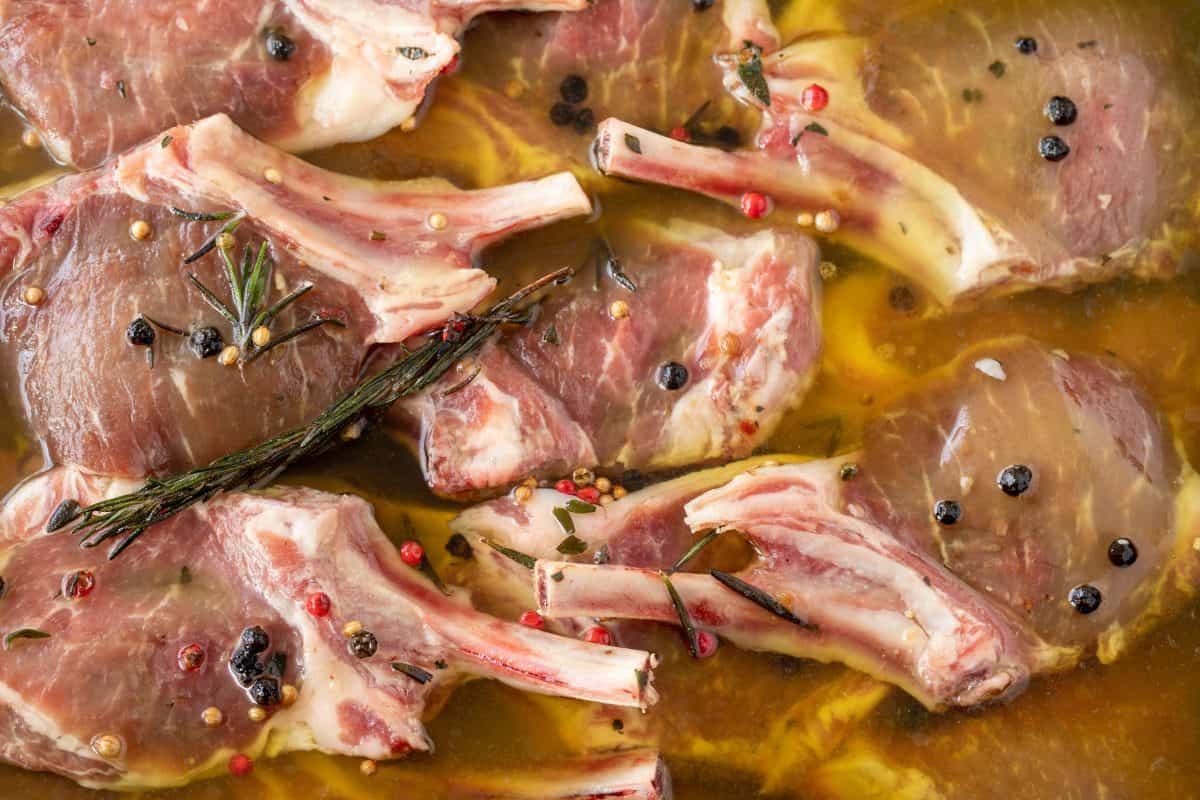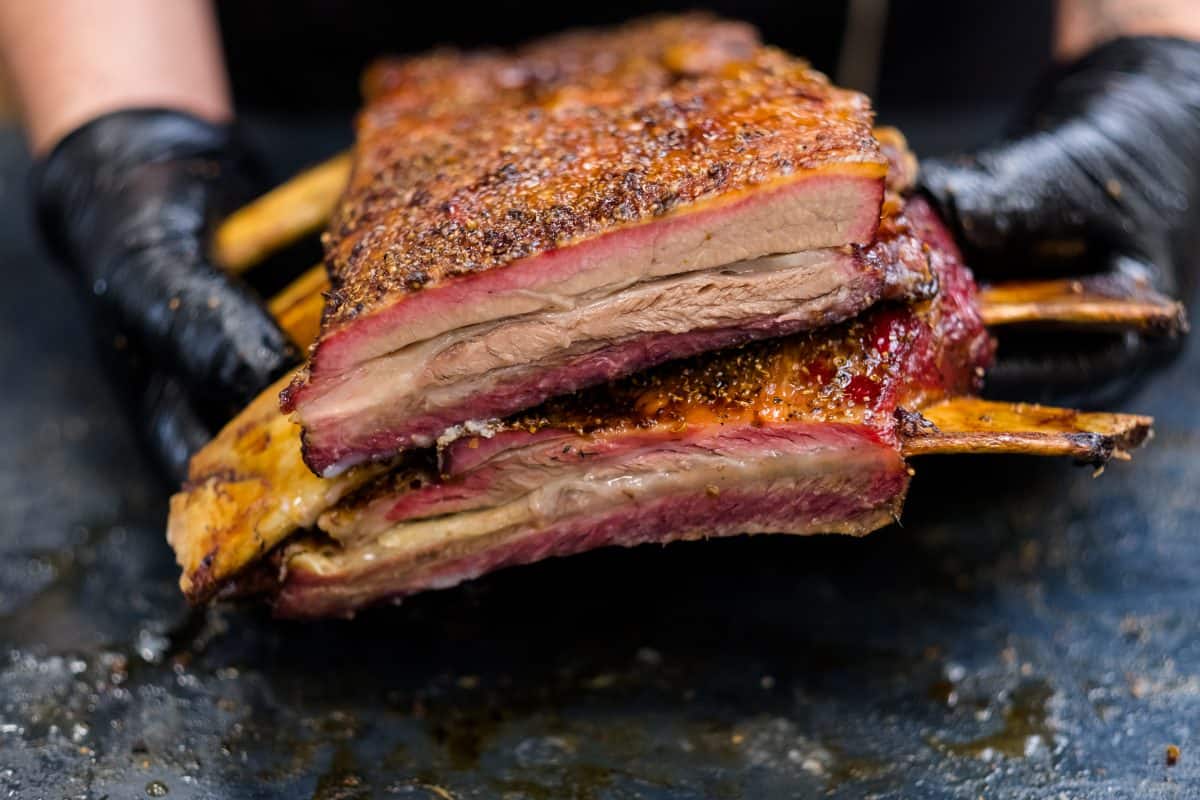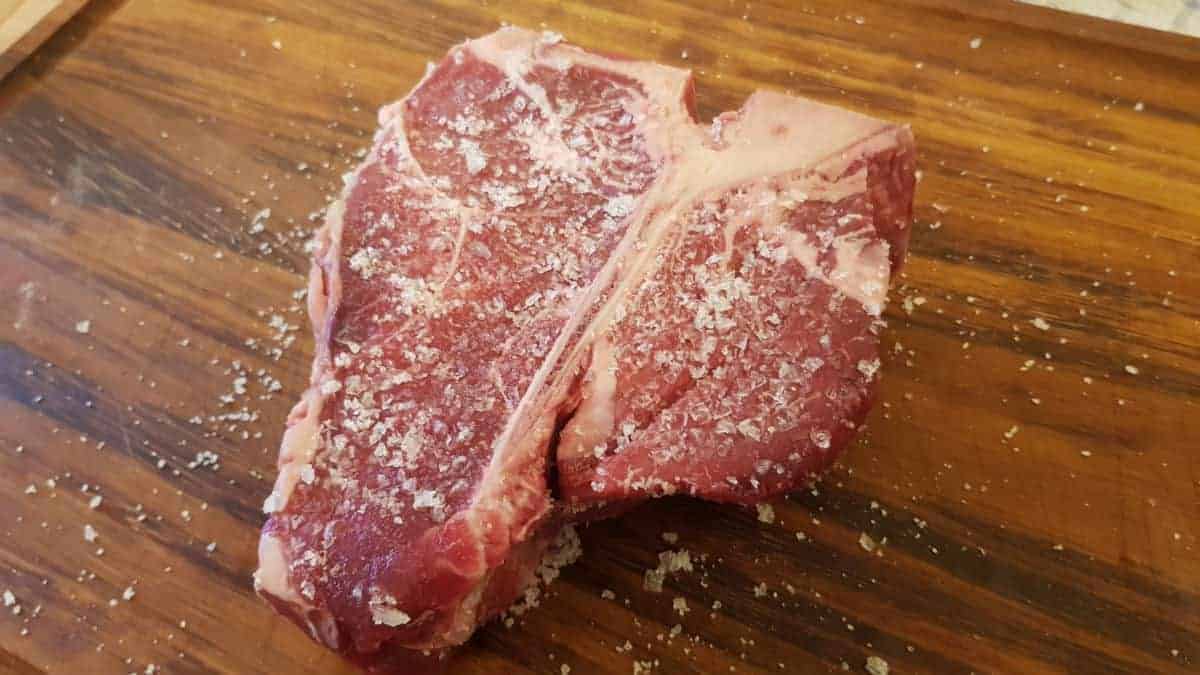Ways to Cook a Beef Bottom Round Rump Roast
And now, for our meat-loving readers, something special…a magic trick! We're going to show you how to turn a $ cut of meat into a $$$ cut of meat. The secret is tenderizing.
With a little cunning technique, you can make that cheap cut every bit as tender, succulent and rich-tasting as the big (pricey) honchos of the meat world. And there are many great ways to do this, from mechanical (pounding) to using acids and enzymes, to cooking at and to a specific temperature.
Yes, in this post we'll be going in depth on how to tenderize meat.
We'll show you that quality and tenderness doesn't have to line up with cost. You can make all meats, regardless of price and "quality" in the supermarket, fork tender and melt in the mouth.
Contents (Jump to Topic)
- 1 What Makes Meat Tough and Chewy?
- 2 5 Ways to Tenderize Meat
- 2.1 Pounding Leads to Tenderness
- 2.2 Tenderize With Enzymes & Acids
- 2.3 Scoring Helps to Tenderize
- 2.4 Slow Cooking Leads to Tender Results
- 2.5 How to Tenderize Meat by Salting & Brining
- 3 What Meats Can I Tenderize and Which Method Should I Use?
- 4 Tender Loving Care!
What Makes Meat Tough and Chewy?
A little nitty-gritty science for you here.
Take your average cow, pig, or lamb that spends its life on all fours. The muscles at the top of the animal, around the backbone and ribs, aren't doing a whole lot, and will have more fat and marbling. So the meat that comes from here will be soft and tender. These are your high-end cuts; prime rib, tenderloin, etc.
Then there's the working parts, the legs, neck and other lower muscles. The meat that comes from these areas will be tough and sinewy. Your budget choices; chuck, brisket, etc. For more on the differences between tender and tough cuts, please click here.
Now muscle is made up of long "strings" of connective tissue. Kind of like a bunch of rubber bands, and I know that is not what you want on your dinner plate. Surrounding these muscle fibers is a thin gelatinous substance, collagen, which can be your friend — tender, juicy, fork-tender -— or not — tough, chewy, shoe leather. It all depends on how you treat it and cook it.
So let's take a look at the different methods of tenderizing meat.
5 Ways to Tenderize Meat
Check out the quick run-through of methods in this short video, then read on as we walk you through the different techniques, and which is best for different meats.
Pounding Leads to Tenderness
Here is one of the few times when damaged and broken is a good thing! Take a meat mallet, yup, the scary-looking tool that looks like something the Vikings may have wielded in battle, and literally hammer the meat.
What happens here is that you are breaking down and tearing apart those tough muscle fibers which will make the cooked meat more tender.
Here's How
Choose a good dish-washer-safe cutting board that can be well-sanitized. Or use wax paper or plastic wrap around the meat to avoid contamination of surfaces.
Seize your weapon (mallet) and use the spiky side. The flat side is for pounding fillets of chicken or veal thin for escalopes etc. If you don't have a mallet, the bottom of a glass or a rolling pin will work. Just go easy!
Now it's important to get the right pressure as you pound. Don't get carried away there, it's already dead, no need to kill it again. If you hammer too hard, you will crush not just the connective fibers, but also the softer meat tissue and end up with mush.
You want to pound it firmly so that you get the print of the spikes on the surface of the meat indicating you have penetrated and broken down those tough fibers. Turn it over, do the same on the other side.
Tenderize With Enzymes & Acids

This is my favorite way to tenderize a tough cut because let's face it, we're not talking prime rib here. The cheaper cuts are going to need some help, and a tasty marinade soak will both tenderize the meat and add terrific flavor.
One of the most important things to include in a marinade: fruit. Turns out the little tropical kiwi is magic at tenderizing meat! Who knew?
The enzymes found in certain fruits do an excellent job of breaking down the proteins that are in muscle fiber and its connective tissue. When these proteins are broken down, the muscle is rendered softer and will be less chewy. Kiwis, pineapple, papaya and mangos are especially good sources of these tenderizing enzymes.
So you're thinking, "but I don't want a tropical fruit-flavored marinade!" But kiwi, in particular, has little to no flavor when combined with other ingredients, so it's an excellent option for adding to any marinade for its tenderizing properties while still allowing you to control the final flavor.
Acids too will break down proteins and produce a beautiful tender meat. Lemon juice, wine, and vinegar — even beer and soda — are all powerful tenderizers. Buttermilk and yogurt to a lesser extent will help tenderize meat because of their acid components.
Here's How
Don't even get me started on my favorite marinades because we'll be here all day!
The important thing is to always include an acid or a fruit enzyme in your marinade when you're tenderizing a tough cut.
But know that if you marinate for too long, the meat can break down completely leaving you with a soggy unappetizing mush. Here's a guide for how long should you marinate chicken, and here's an easy reference chart showing how long to marinate different types of meat.
Top Tip
When marinating with acids and enzymes, always use a non-reactive container such as glass or Ziploc bags. Use a metal bowl and your food can take on a metal like flavor.
Many people also like to inject their meat, rather than soak in marinade, to help tenderize and keep it moist during a cook. We have a couple of guides to this if you're looking for a chicken injection recipe, or for the best brisket injection. And we'll be adding more soon.
Scoring Helps to Tenderize
If you're nervous about damaging the meat too much with a mallet, you can use a sharp knife instead.
Look for the "grain" of the meat. The grain is basically the direction of the muscle fibers and kind of looks like ribbons or stripes running in one direction on the meat.
Here's How
To score meat, make light but firm incisions a couple of millimeters deep in a cross-hatch pattern going across the grain. Again, this literally breaks the muscle fibers and will reduce the chewiness of the final product.
With both pounding and scoring, it's important to cut across the grain when you serve. Thin slices will also prevent jaw fatigue from long chewy fibers!
Slow Cooking Leads to Tender Results

OK, here's another hallelujah-in-the-mouth experience for you… fall apart, buttery-soft, slow-cooked meat that is tenderized by hours of cooking at low temperatures. This fork-tender nirvana can be achieved with dry heat on the grill or in the smoker, or wet heat where the meat is braised in liquid for several hours.
What's happening here is the connective tissue — which is largely collagen that surrounds the tough muscle fibers — melts and creates a beautiful juicy moistness. But heat, time and technique are essential here. Get the temperature wrong, and you may as well go find an old sneaker by the door and chew on that.
Here's How
Dry Heat
Season your meat as you wish and if using a marinade, pat it dry with paper towels. Nothing good ever came from wet meat on the grill.
Now the only way to break down that pesky collagen is with low heat and long slow cooking. There's no quick shortcut here. This method takes planning and patience.
Fire up the grill or smoker to around 225-250 °F (xx °C), set up your thermometer (check out our guide to wireless smoker and grill thermometers if you don't have one!) and go find a good book. It's going to be a few hours.
You're looking for an internal temperature of around 160 °F or higher. Only at this temperature will the collagen become moist and tender. Cooked to a lower temperature than 160 °F, the collagen actually shrinks and tightens making the meat dry and tough (hey, we've all been there, right?).
Once the internal temp has reached 160°, check out the appearance and color. If the "crust" is not crisp and caramelized enough for you, do a quick "reverse sear" on it.
Take the meat out to rest, crank the grill up really high (like 500 °F) and put it back on for a few minutes each side until you've got the sear that dreams are made of.
Wet Heat
Using a slow cooker or a Dutch oven, you can create some wonderfully fall-off-the-bone dishes while also dialing up the flavor by adding seasonings to the braising liquid. Wine, spices, herbs and vegetables, the possibilities are endless. As with dry heat, the trick is low heat and long time.
Always start by browning the meat on all sides over high heat in your Dutch oven or heavy-based pan. This is going to achieve that rich dark and flavorful surface like the sear with dry heat.
Remove the meat, and deglaze the pan with pretty much any liquid you like: Wine, beer, broth or water. Add in your seasonings, veggies, onions, spices etc. Back in goes the meat and cook with the lid on tightly at around 300 °F for about 2.5–3 hours. Oven is best, but stovetop can work well too as long as you can keep that heat nice and low.
How to Tenderize Meat by Salting & Brining
Salt is right up there with the Great Pyramids and the Hanging Gardens of Babylon as one of the great wonders of the world. It heals wounds, takes out stains, de-ices the driveway, deodorizes, cleans, too much will kill you, too little will kill you. Fascinating stuff!
And yes, salt can help tenderize and add important moisture and juiciness to tough cuts of meat too. But you have to be careful because salt can also draw moisture out of meat which is why it's not a good idea to add it to marinades that meat will soak in for hours.
There are two ways to use salt as a tenderizer: dry salt and brining (liquid).
Dry Salt (Dry Brining)

No time? No marinade? No mallet? Let salt work its magic on that tough cut of meat.
Here's How:
Spread a generous layer of coarse, kosher or sea salt over the meat, all sides, work it in with your fingers and leave for an hour if possible. Don't use table salt because it's too fine and will over-salt the meat.
The salt will draw out the natural juices (don't panic!) which will then dissolve the salt creating a mini brining solution. This brine will then be reabsorbed into the meat, adding moisture back in and also tenderizing it. Ta-da! Told you it was magic!
Just be sure to rinse the meat well after about 45 minutes to an hour, and pat dry before taking it to the grill. The meat will look a little darker, this is natural and not a problem.
Brining
As discussed in our depth guide, what is brining, wet brining is another method that uses the magic of salt, but in a solution. Salt-water basically.
Brining has two benefits:
- Like acids and enzymes, it tenderizes by dissolving part of the protein structure of the muscle fibers.
- It also enables the meat to retain more water through osmosis (see, that middle school bio class was useful after all!) which will result in the meat being "plump" and tender as well as a lot easier on the chewing.
Count on using 1 cup of salt to 1 gallon of water. And you're going to want to leave the meat to soak for roughly an hour per-pound of weight. For more detail on the dos and don'ts of brining, check this article from food52.com.
And for more fun facts on the magic, history and science of salts, check out our guide to the many different kinds of salt.
What Meats Can I Tenderize and Which Method Should I Use?
You can see there are plenty of great ways to make a tough cut tender. Which one you choose depends on what kind of meat you're preparing and how much time you have.
And of course, you're not going to be using any of these methods with the high-end cuts which are tender and fat-rich to begin with and require a different approach entirely with cooking and grilling.
So when you're feeling fancy (or rich!), go get your prime rib, tenderloin, or fillet steak and head straight to the grill. Small and delicate fare like chicken breasts and seafood also require no tenderizing.
But if you're looking to save some moolah and serve up a tender, juicy dish fit for a king, check out this chart for quick tips on my recommended tenderizing method and timing:
| Type of Meat | Best Methods to Use | Time Needed | Pro Tip |
|---|---|---|---|
| Round, flank, skirt, top blade or hanger steak | Pounding, marinating, salting | Pounding: couple minutes. Marinating: 1–12 hours | Cook quickly to medium-rare. Slice thinly across the grain |
| Brisket | Slow cooking | Slow cooking: 2.5–3 hours. Brining: 1 hour per-pound | Wrap in foil when meat temperature "stalls" to keep the cooking going. Reverse sear to finish with great bark. |
| Ribs | Slow cooking, brining | Salting: 24 hours ideally, 3–4 hours minimum./ Braising: 2–3 hours | Wrap in foil when meat temperature "stalls" to keep the cooking going. Reverse sear to finish with great bark. |
| Chuck, shoulder or rump roast | Brining, braising | 14–18 mins. | Always sear on all sides in a hot pan first to get great depth of color and flavor. |
| Top & bottom round | Brining | Depends on recipe | |
| Shank | Braising | 3 hours | |
| Chicken breasts, pork chops | Brining, pounding, marinating | Brining: no more than 1 hour per-pound Marinating: 1–3 hours, be careful not to over "cook" meat to mush by marinating too long. | Pound gently with flat side of mallet for smaller cuts. |
| Whole turkey/chicken | Brining | Turkey: 16–24 hours chicken: 4 hours | The concentration of your brine will affect brining time. Add a little sugar to the brine to get a great caramelized crispy skin. |
Tender Loving Care!
The thing is, contrary to what many think, the final texture and perceived quality of meat doesn't have to be about the cut or the cost, but about how it's treated before and during cooking.
So learn to love those tough cuts by giving them a little TLC. You'll be amazed how fork-tender and juicy cheap cuts can be with the right amount of tenderizing attention. And you'll save yourself some money too. Now that's magic!
Happy grilling!
Source: https://www.foodfirefriends.com/how-to-tenderize-meat/
0 Response to "Ways to Cook a Beef Bottom Round Rump Roast"
Post a Comment